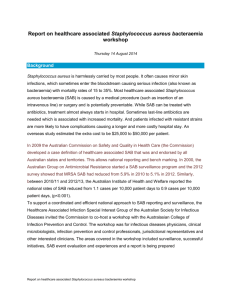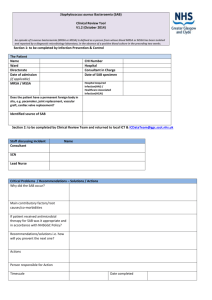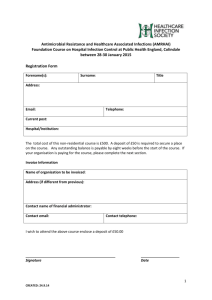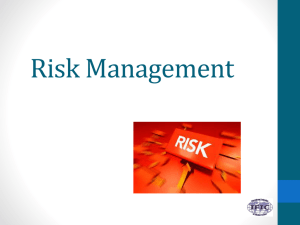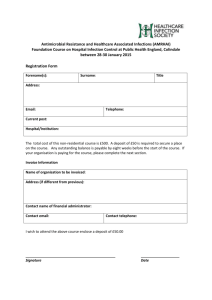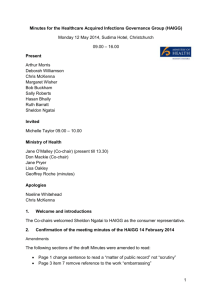Surveillance-Validation-Guide-for-healthcare
advertisement
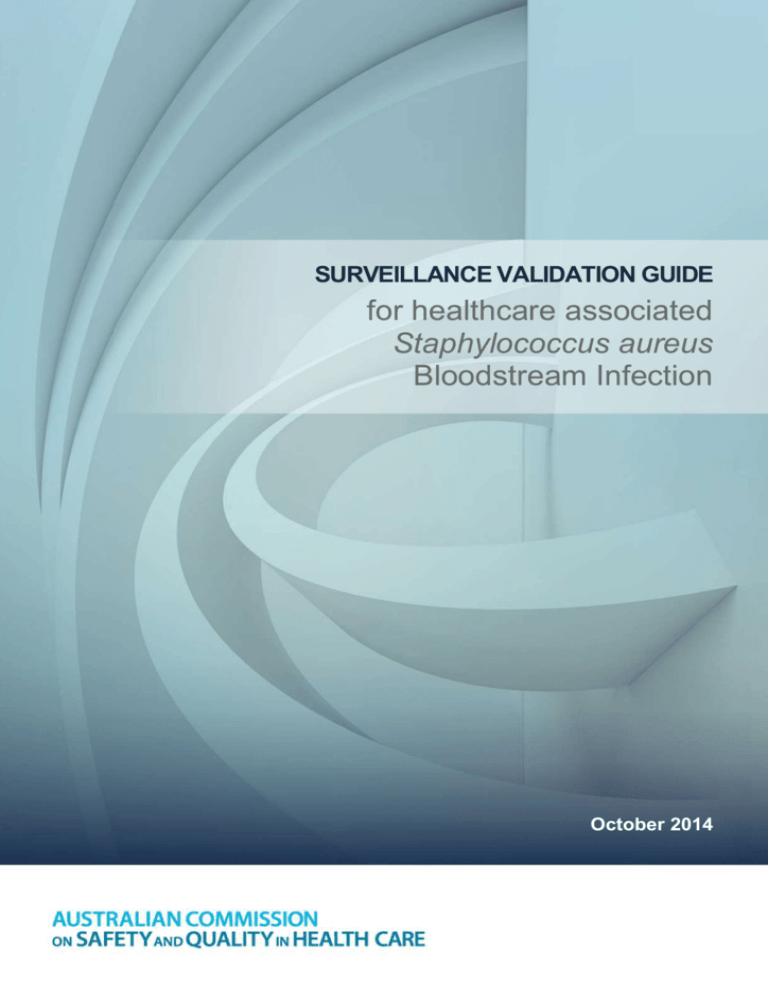
SURVEILLANCE VALIDATION GUIDE for healthcare associated Staphylococcus aureus Bloodstream Infection October 2014 Introduction Accurate, high quality data are important for setting infection prevention priorities and measuring progress. The surveillance of healthcare associated Staphylococcus aureus Bloodstream Infection was endorsed as a national priority by Australian Health Ministers in December 2008. State-wide rates of Healthcare Associated Staphylococcus aureus Bloodstream Infection (HA SAB) are now used as a performance indicator of safety and quality in the Australian Healthcare Agreement (2012), and individual hospital data are now made publicly available on the MyHospital website. Although efforts have been made to ensure the accuracy of these data via the development and acceptance of a national standard definition, 1 it is recognised that formal validation processes are required to ensure that data are as robust as possible.2 The need for validation becomes obvious when considering the nature of the current systems for reporting pathology results and recording of patient admission and discharge data. There are a variety of different pathology information systems in use throughout Australia and many different patient administration systems that collect data on patient admissions. The complexity and variation of HA-SAB data collection across the country will not permit a ‘one size fits all’ approach to SAB data validation. To overcome this issue, several options for data validation are presented. This document has been prepared in order to provide those with responsibility for surveillance with information on methods that can be adopted at both the hospital and jurisdictional level for validation of data submitted for national data collections. The information uses SAB data as the case study, but the principles may be applied to collection of surveillance data on other healthcare associated infections. Surveillance validation guide for healthcare associated Staphylococcus aureus Bloodstream Infection 2 Validation of numerator data When validating infection surveillance data, there are two important considerations: The reliability and validity of obtaining the current number of cases of infection The validity associated with ensuring the correct classification of infections (application of national definitions in case assignment i.e. healthcare associated versus community associated). Therefore, a process that examines each of these points is important. This section describes a selection of methods which could be used to validate HA-SAB data. 1 Intrinsic data validation This is an automated process built into a computer system that improves data quality by restricting the values and types of data that are entered into the system. This is useful for controlling data entry errors and misclassifications but does not control for the omission of cases that should have been entered into the database and therefore does not check for the completeness of data. 2 Internal data validation processes This involves a systematic checking of data by periodic descriptive analysis of collected data to detect unusual or unexpected values with subsequent follow-up and correction, if required, of aberrant or outlier results. Hospitals may also wish to implement a process by which an infection control practitioner or infectious diseases physician/microbiologist who has not been involved in the initial data collection and determination, independently examines a selection of SAB cases to determine their classification. This is subsequently cross-checked against existing data. Surveillance processes should also be monitored to ensure changes in rates are not due to underlying issues with the systems in place. Internal data validation is vital to ensure data accuracy for quality improvement activities. Internal data validation also provides an opportunity to correct any errors or omissions prior to data submission of the data to jurisdictional surveillance units. 3 Validation of data by external party This is data validation performed by an agency external to the facility, e.g. jurisdictional surveillance unit. Validation by an external party involves the checking of a sample of data with an assessor independently classifying infections using the set definitions. Variations and errors are then systematically reviewed.3 4 Validation of internal data against external dataset This may involve the acquiring of data from an independent source such as a pathology database and the crosschecking of these data with the surveillance data. Options are summarised below: a. Obtaining a direct data extract of all blood cultures positive for Staphylococcus aureus from laboratories to check for missing infections, or changes in trend. This could be undertaken on an intermittent basis (e.g. quarterly or annually) or undertaken on a continuous basis, especially if the process can be semi-automated. The proportion of infections that are healthcare associated should not vary dramatically in a short period of time, unless there has been a dramatic change in the epidemiology of the infection (Figure 1). Significant variations in trend would alert to the potential of error. Comparisons between passive surveillance data and data derived from infection control surveillance for the time period under review could be undertaken at either the hospital or jurisdictional level to identify any major inconsistencies. Surveillance validation guide for healthcare associated Staphylococcus aureus Bloodstream Infection 3 Figure 1. Example of a comparison plot of surveillance data and laboratory supplied data Validation of internal data against external dataset (continued) b. Obtaining a direct data extract of all blood cultures with Staphylococcus aureus from laboratories as per Option (a), but also linking these data with a patient administration system to identify cases of SAB occurring >48 hours after admission. In this case the variation between the hospital onset SAB and the SAB classified as healthcare associated by the infection control team would be investigated. This would provide both a case finding and case classification validity check.4 c. Use of an automated laboratory notification process that notifies a jurisdictional surveillance unit of every positive Staphylococcus aureus blood culture (similar to the notifiable diseases process used by public health authorities). This provides an assurance that infections are not missed. Jurisdictional surveillance units can check that all of these infections have been monitored and classified appropriately by contributors.5 5 Validation of Infection Control Practitioner surveillance skills There are a number of ways in which this can be accomplished, two examples being: a. Accredited surveyor system This system involves a person responsible for collecting SAB surveillance data being externally examined using a standardised assessment tool by an accredited surveyor. The assumption is that people who pass this examination are the only persons authorised to undertake SAB surveillance data submission to a jurisdiction. b. Case series validation system This system can be used to determine variations in practice, and involves persons responsible for collecting SAB surveillance data undergoing a test. The test may involve case scenarios and require the person to correctly identify the classification of SAB.6 Surveillance validation guide for healthcare associated Staphylococcus aureus Bloodstream Infection 4 6 Denominator data validation The denominator data used for SAB surveillance are usually provided by the medical statistics department of the hospital. It is important that surveillance personnel are familiar with the way that these data are obtained; have documentary evidence that the extracted data meet the national definitions for patient days; and that the correct inclusion and exclusion criteria are applied. This will usually involve direct communication with those responsible for generating the data extract. References 1. Implementation Guide for the Surveillance of Staphylococcus aureus bacteraemia. Australian Commission on Safety and Quality in Health Care. Sydney. 2013. 2. Cheng, A.C., Bass, P., Scheinkestel, C., Leong, T. Public reporting of infection rates as quality indicators, Medical Journal of Australia. 2011; 195(6):326-327. 3. McBryde, E.S., Brett, J., Russo, P.L., Worth, L.J., Bull, A.L., Richards, M.J. Validation of state-wide surveillance system data on central line-associated bloodstream infection in intensive care units in Australia. Infection Control and Hospital Epidemiology. 2009; 30(11):1045–1049. 4. Queensland Health Centre for Healthcare Related Infection Surveillance and Prevention (CHRISP) – personal communication, September 2013. 5. Mitchell, B., Gardner, A., Stewart, L. The epidemiology of Staphylococcus aureus bacteraemia in Tasmania. Healthcare Infection. 2012; 17(3):98-103. 6. Worth, L.J., Brett, J., Bull, A.L., McBryde, E.S., Russo, P.L., Richards, M.J. Impact of revising the National Nosocomial Infection Surveillance System definition for catheter-related bloodstream infection in ICU: reproducibility of the National Healthcare Safety Network case definition in an Australian cohort of infection control professionals. American Journal of Infection Control. 2009; 37(8):643-648. Surveillance validation guide for healthcare associated Staphylococcus aureus Bloodstream Infection 5 Australian Commission on Safety and Quality in Health Care Level 5, 255 Elizabeth St, Sydney NSW 2000 GPO Box 5480, Sydney NSW 2001 Phone: (02) 9126 3600 (international +61 2 9126 3600) Fax: (02) 9126 3613 (international + 61 2 9126 3613) Email: mail@safetyandquality.gov.au www.safetyandquality.gov.au Surveillance validation guide for healthcare associated Staphylococcus aureus Bloodstream Infection 6
